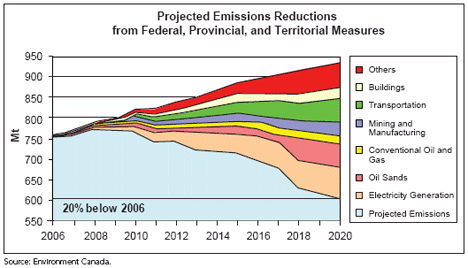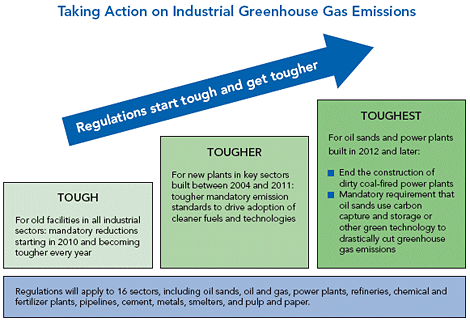Government delivers on emissions plan
 Ottawa, Canada (GLOBE-Net) - The federal government has released detail of an aggressive regulatory framework designed to reduce Canada’s greenhouse gas emissions by 20% of 2006 levels by 2020. Building on the Turning the Corner framework announced in April 2007, the new federal plan outlines details of a national carbon offset trading program as well as progressively tougher new regulations to tackle emissions from two of Canada’s top emitting sectors: oil sands and electricity.
Ottawa, Canada (GLOBE-Net) - The federal government has released detail of an aggressive regulatory framework designed to reduce Canada’s greenhouse gas emissions by 20% of 2006 levels by 2020. Building on the Turning the Corner framework announced in April 2007, the new federal plan outlines details of a national carbon offset trading program as well as progressively tougher new regulations to tackle emissions from two of Canada’s top emitting sectors: oil sands and electricity."Last April, this government made a commitment to Canadians to cut our greenhouse gas emissions an absolute 20% by 2020," said Environment Minister John Baird. "Today, we are announcing the details of those tough measures that will put us on a path to meet our commitments."
The tough new regulatory regime will be a key driver for the development of technologies to move Canada closer to a low-emission economy. Today greenhouse gas emissions are 25% higher than they were in 1990, putting the country more than 32% above its Kyoto target. Without immediate action, Canadian GHG emissions are projected to grow a further 24% by 2020 and reach about 940 megatonnes per year - 58% above 1990 levels.
The plan released today is intended to:- Establish a market price for carbon;
- Force industry to reduce its greenhouse gas emissions; and to
- Set up a carbon emissions trading market, including a carbon offset system.
In addition, today’s detailed regulations include new measures to:
- Set a target that will effectively require oil sands starting operations in 2012 to implement carbon capture and storage; and,
- Ban construction of new dirty coal plants starting in 2012.

"Our regulations will apply to all big industry," said Minister Baird. "From the oil industry to chemical companies; from smelters to pulp and paper mills, all big industry will have to do their part."
The primary focus of the framework is on the energy and electricity sectors. These sectors will face progressively tougher requirements to improve their emissions performance each year. The government believes the proposed approach will reduce industrial emissions by 165 megatonnes per year by 2020. Facilities which began operation in 2004 or after will face even tougher requirements and will be forced to use cleaner fuels and green technology.
New oil sands coming into operation in 2012 or later will be required to use the cleanest technology possible, and to have built in capacity for carbon capture and storage.
The oil sands are one of Canada’s greatest natural resources and a major engine of the national economy; but without firm action today, emissions from oil sands will grow dramatically in the coming years, notes the background documents released in tandem with the Ministerial statement..
Coal-fired power plants will be subject to the same requirements as oil sands projects. According Environment Canada, ‘it is simply irresponsible to keep building dirty coal-fired plants. Coal will have to meet a tough new standard.
It is expected that the regulatory requirements on oil sands and coal-fired power plants will account for 90 megatonnes of the 165 megatonne target.

Companies will be able to choose the most cost-effective way to meet their emission reduction targets from a range of options: in-house reductions, contributions to a capped time-limited technology fund, domestic emissions trading and offsets and access to the United Nations’ Clean Development Mechanism.
Companies that have already reduced their greenhouse gas emissions prior to 2006 will have access to a limited one-time credit for early action. These credits are for a maximum of 15 megatonnes of reduced emissions with one credit representing one tonne.
The credits will be fully tradable and bankable as part of the framework’s proposed national carbon offset program.
The offset program is designed to encourage cost-effective domestic greenhouse gas reductions or removals in activities that are not expected to be covered by proposed industrial air emissions regulations. The offset system will be administered under the Canadian Environmental Protection Act, 1999, and will be eligible to projects that achieve real, incremental, quantified and verified reductions in greenhouse gas emissions.
There is no minimum project size for the offsets and projects will be verified by the government of Canada before receiving offsets.
Even with these requirements, it is expected that the electricity sector will remain the largest single contributor to greenhouse gas emissions in Canada, releasing 90 megatonnes per year in 2020.
To address this, the federal government also will establish a task force to work with the provinces and industry to reduce these emissions by 25 megatonnes by 2020, through increased hydro, renewable and nuclear electricity production and through further development of the national grid.
Addressing industrial emissions is just one part of the Government’s plan to reduce greenhouse gases and air pollution. The Government of Canada is taking further action that will cut greenhouse gas emissions from transportation and buildings. These actions include:
- Mandatory renewable fuel content in gasoline, diesel and heating oil;
- Introducing tough, new fuel standards for cars, light trucks and SUVs;
- New energy efficiency requirements for a wide range of commercial and consumer products, such as dishwashers and commercial boilers; and
- New national performance standards what will ban inefficient incandescent light bulbs.
Environment Canada believes that these actions could result in further greenhouse gas emission reductions of 65 megatonnes from projected 2020 levels.
With a long-term goal that envisions greenhouse gas emission reductions of 60 to 70% by 2050, Turning the Corner will continue to evolve as new technology and new ways of improving our environment are discovered.
According to Environment Canada, provincial governments have already committed to targets that would require achieving greenhouse gas reductions of as much as 300 megatonnes by 2020. This would be in addition to the government plan which will not only meet its 20% reduction target, but to potentially surpass it.
In order to refine and improve the regulatory approach, the Government consulted extensively with environmental groups, industry and other stakeholders over the past year. This period of consultation was important to ensure Canada’s regulations would result in real reductions of greenhouse gases. The Government sought to accommodate stakeholder views where reasonable, but remained focused on the primary objective of keeping its commitment to reduce greenhouse gases.
Proposed greenhouse gas regulations are expected to be published in the Canada Gazette later this year, and the regulations finalized in 2009 to come into force as planned on January 1, 2010.
With the release of this framework with real targets and timelines, it seems that the Government of Canada is signaling in real terms that it is willing to do what is needed to ensure that once again that Canada becomes a global environmental leader.
More details on the planned measure are available at these locations:
- 1. Taking Action to Fight Climate Change
HTML - PDF (634 KB) - 2. The April 2007 Regulatory Framework for Industrial Greenhouse Gas Emissions
HTML - PDF(223 KB) - 3. Canada’s Offset System for Greenhouse Gases
HTML - PDF(1408 KB) - 4. Canada’s Credit for Early Action Program
HTML - PDF(443 KB) - 5. Detailed Emissions and Economic Modelling
HTML - PDF(1533 KB)
You can return to the main Market News page, or press the Back button on your browser.

